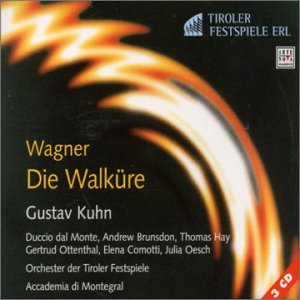The release of this 3CD set from Arte Nova completes the Ring cycle recorded at live performances across four years at the Tirol Festival. The company maintains its high standard of recorded sound, and there is a well produced booklet complete with synopsis and clear cueing points. However, the libretto dodges the issue and offers the text in German only, thus compromising the value of the bargain to be had at the attractive budget price.
Like the other music dramas in the Ring cycle, Die Walküre is big enough and strong enough to stand on its own. In any case the cast assembled here is very different from those which appeared in the previous performances. It is not hard to understand why, since the Festival uses mainly young singers whose names are not advance selling points. They are talented enough to do justice to Wagner's demanding score, however, even if the strains of live performance (no retakes) and of Wagner's hugely demanding score do sometimes take their toll.
The constant factors are the conducting of Gustav Kuhn and the playing of the Tirol orchestra. Kuhn brings a keen sense of drama to his musical direction, and the tensions never sag. The orchestra is better still, producing a rich and warm sound, with plenty of rhythmic attack whenever it is required. These contributions are the best aspect of the performance, and they are not to be under-valued.
What of the singers? The leading roles are all skilfully sung, and their demands are adequately met. The Italian bass-baritone Duccio dal Monte sings Wotan, and as we might fear his command of German is unsteady. This puts greatest strain on his lengthy monologue in Act II, which does become challengingly tedious for listener since the libretto is of help to fluent German speakers only. Perhaps with more experience of the role dal Monte will bring more command to it. And in Die Walküre Wotan should be at his most commanding.
As Brünnhilde Elena Comotti has an attractive bloom to her voice, but she took lacks the intensity of emotion which this great role demands. As a result the larger part of Act III fails to catch fire, save for the very end when the orchestra flickers for the Magic Fire Music. Another promising young singer, the tenor Andrew Brunsdon, takes the role of Siegmund, but his voice lacks the rich tone of the true heldentenor. He does sing with some feeling for the words, however, and is a name to watch for in the future. His Winterstürme, towards the end of the first act, is the highlight of his performance.
The best singing performances come from the Hunding, Sieglinde and Fricke. Hunding is one of Wagner's least appealing characters, but Thomas Hay makes the most of his opportunities in Act I and brings him to life. Both Gertrud Ottenthal and Julia Oesch sound well, and seem thoroughly inside their roles; the former's confused emotional state during the initial stages of the drama is very well characterised.
Since this is a live performance, listening to the discs is an experience which offers all the usual advantages and disadvantages. On the credit side, there is a real sense of pace to the drama, thanks to the conducting of Gustav Kuhn, and the audience makes few disturbing contributions. However, the stage movements can be a problem and are all too frequently heard, while the movements of the singers can sometimes damage the perspective in which they are featured by the microphones.
This creditable release is well worth hearing, but in truth it is worth spending a little more, partly for the sake of the performance, partly for the sake of accessing a libretto.
Terry Barfoot


